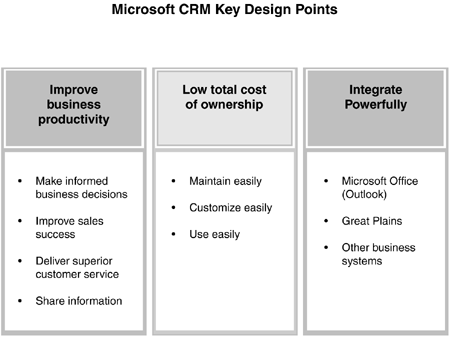Chapter 4. Microsoft CRM Functional and Conceptual Overview
In this chapter
Microsoft Business Solutions, Microsoft, and Microsoft Great Plains
Microsoft CRM Product Positioning
Microsoft CRM Versions and Licensing
Microsoft CRM User Interfaces
Named User Licensing
CRM Platform
Microsoft CRM Concepts
Opportunities and Cases
Core CRM Objects
Use Case Corner—Expediting Activity Record Creation
Summary
Those familiar with CRM packages are aware that they all go about things a little differently. This chapter helps you gain a conceptual understanding of Microsoft's application and outlines and defines the system's functionality as well as terminology. Keep in mind as you read this information that this chapter, and the content of this book, refer to Version 1.0 of Microsoft CRM.
Before launching into a discussion of functionality, let's first establish a definition of the word. Dictionary.com defines the word functional as “designed for or adapted to a particular function or use.” Functionality is then defined as “the quality of being functional.” Computer-based business applications are generally designed to provide functionality in one of three areas:
Tracking real-life transactions, events, and interactions for the purpose of sharing the information with others and to ensure that the information is not lost or forgotten.
Analyzing these recorded transactions, events, and interactions to gain knowledge that will provide future benefit.
Facilitating the execution of the transactions, events, and interactions so that present activities can be done with fewer resources.
On the tracking side, the end goal is to make the capture of the transactions, events, and interactions as easy as possible. We do this to share and remember the information so that it can help us in the future. On the analysis side, the end goal is to provide the greatest insight into the recorded information. On the facilitating side, the application functionality should save us work in carrying out our job duties.
It stands to reason that any functionality described hereon should fall into one of the three areas listed previously. In fact, as illustrated in Figure 4.1, this maps right into Microsoft's key design point of “Improving Business Productivity” by
Making informed business decisions (Analyzing)
Improving sales success (Facilitating)
Delivering superior customer service (Facilitating)
Sharing information (Tracking)
Figure 4.1. Microsoft's Key Design themes in developing Microsoft CRM.

That's enough of the theory; let's move on to the meat of the matter. At a very high level, Microsoft CRM is billed as encompassing Sales Force Automation, Customer Service, “lite” Marketing and Reporting Functionality. However, delving deeper into the application you find that Microsoft CRM is comprised of the following functional areas:
Lead Management
Contact Management
Account Management
Activity and Task Management
Calendar
Opportunity Management
Sales Forecasting
Sales Process Management
Quote Generation
Service Case Management
Service Contract Management
Order Management
Invoice Generation
Sales Literature
Knowledgebase
Reporting
Announcements
Customization Tools
Security and User Management
Workflow and Routing Tools
Workflow Manager
Workflow Monitor
Implementation Tools
Deployment Manager
What is perhaps most deceiving about the application itself is its almost cartoon-like appearance at first glance. The thoughtfully laid out screens with their colorful icons give the impression of a game more than a business application. Don't be fooled; behind this user-friendly facade is surprisingly deep functionality; especially for a first release product.
